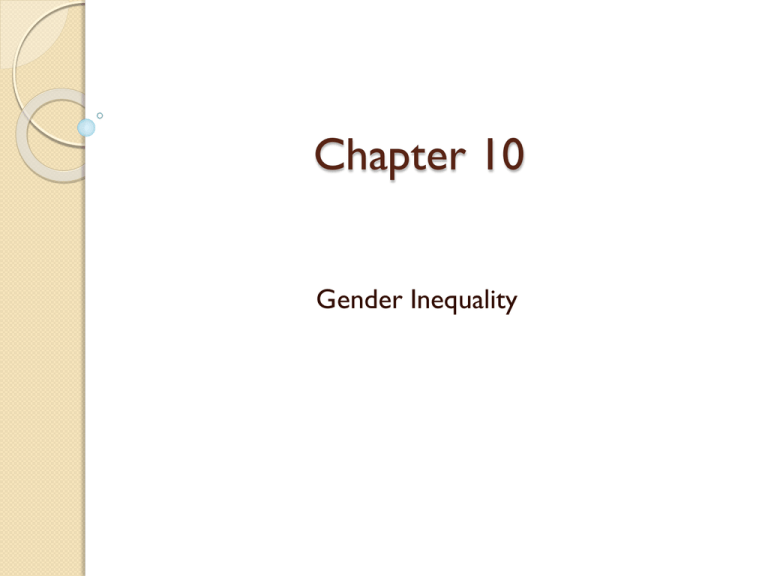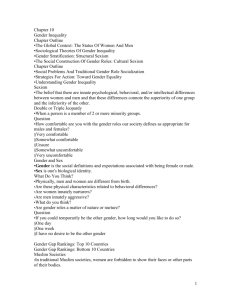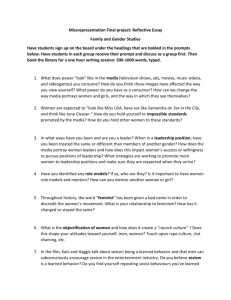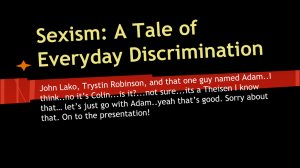Chapter 8, Gender Inequality
advertisement

Chapter 10 Gender Inequality Sexism The belief that there are innate psychological, behavioral, and/or intellectual differences between women and men and that these differences connote the superiority of one group and the inferiority of the other. Double or Triple Jeopardy When a person is a member of 2 or more minority groups. Gender and Sex Gender is the social definitions and expectations associated with being female or male (on a continuum from hyper masculine to hyper feminine). Sex is one's biological identity (usually either/or) XX or XY Gender Gap Rankings: Top 10 Countries Country Rank Country Rank Norway 1 Philippines 6 Finland 2 Denmark 7 Sweden 3 Ireland 8 Iceland 4 Netherlands 9 New Zealand 5 Latvia 10 United States 27 Gender Gap Rankings: Bottom 10 Countries Country Rank Country Rank Bahrain 121 Benin 126 Ethiopia 122 Pakistan 127 Turkey 123 Saudi Arabia 128 Egypt 124 Chad 129 Morocco 125 Yemen 130 Muslim Societies In traditional Muslim societies, women are forbidden to show their faces or other parts of their bodies. Some women adhere to this out of fear, others believe veiling was first imposed out of respect for women and the desire to protect them. Structural Functionalist Perspective Pre-industrial society required a division of labor based on gender. ◦ Women nursed and cared for children. ◦ Men were responsible for material needs. Industrialization made traditional division of labor less functional, belief system remains. Conflict Perspective Continued domination by males requires a belief system that supports gender inequality. Two beliefs: ◦ Women are inferior outside the home. ◦ Women are more valuable in the home. Symbolic Interactionist Perspective Gender and gender roles are learned through socialization process. ◦ Women are socialized into expressive roles. ◦ Men are socialized into instrumental roles. Advertising and Sexism This billboard is a good example of the cultural emphasis placed on women’s physical appearance. Traditional Roles Expressive roles ◦ Roles into which women are traditionally socialized, i.e., nurturing and emotionally supportive roles. Instrumental roles ◦ Roles into which men are traditionally socialized, i.e., task-oriented roles. Structural Sexism The ways in which the organization of society, and specifically its institutions, subordinate individuals and groups based on their sex classification. Education and Structural Sexism Worldwide, women are less likely than men to be literate. In U.S. men are more likely to have doctorate degrees. Women are socialized to choose marriage and motherhood over career preparation. Science and Engineering Doctorates Awarded to Women, 2005 Work and Structural Sexism According to the International Labor Office (ILO), in 2007, women made up nearly 50% of the world’s total labor force. Worldwide, women tend to work in jobs that have little prestige and low or no pay, where no product is produced, and where they are the facilitators for others. Women are more likely to hold positions of little or no authority and to have more frequent and longer periods of unemployment. Highly Sex-Segregated Occupations 2003 Female-Dominated Occupations % Female Workers Secretaries and administrative assistants 96.5 Elementary and Middle School Teachers 81 Registered Nurses 90.1 Nursing, psychiatric, and home health aides 87.7 First-line supervisors/managers of retail sales workers 43.2 First-line supervisors/managers of office and administrative support workers 68.6 Highly Sex-Segregated Occupations 2003 Male-Dominated Occupations % Male Workers Airplane pilots and navigators 95 Architects 76 Automobile mechanics 98 Civil engineers 87 Clergy 85 Highly Sex-Segregated Occupations 2003 Male-Dominated Occupations Construction workers Dentists Firefighters % Male Workers 97 78 97 Grounds maintenance workers 92 Glass Elevator Effect The tendency for men seeking or working in traditionally female occupations to benefit from their minority status. Pink-collar Job Jobs that offer few benefits, often have low prestige, and are disproportionately held by women. Glass Ceiling An invisible barrier that prevents women and other minorities from moving into top corporate positions. Income and Structural Sexism Women are twice as likely as men to earn at or below minimum wage. In 2007, full-time working women had median weekly earnings of $612, compared with full-time weekly earnings of $771 for men. The U.S. gender gap in pay has decreased over the years, from women making 60% of what a man made in 1980 to nearly 80% of what a man makes today. Effects of Education and Sex on Weekly Earnings of Full-Time Workers, 2008 Educational Attainment Men Women Total, 25 years and older 771 613 Less than 1 year of high school 413 321 Four years of high school 492 382 High school graduate 652 493 Gender Gap Hypotheses Devaluation hypothesis ◦ Argues women are paid less because the work they do is socially defined as less valuable than the work performed by men. Human capital hypothesis ◦ Argues that female-male pay differences result from differences in women's and men's education, skills, training, and work experience. Emotion Work Work that involves caring for, negotiating, and empathizing with people. It is exhausting… Comparable Worth The belief that individuals in occupations, even in different occupations, should be paid equally if the job requires “comparable” levels of education, training, and responsibility. In a comparable worth lawsuit, nurses successfully sued the City of Denver for paying them less than other employees (e.g., tree trimmers, sign painters) who had less education. % of Women Elected by Level of Government Position, 2005 Position Number of Seats Number of Women U.S. President 1 0 U.S. Vice President 1 0 U. S. Congress 535 96 % of Women Elected by Level of Government Position, 2005 Position Number of Seats Number of Women House 435 70 Senate 100 16 Governors 50 9 State Legislators 7,382 1,734 The Second Shift According to Hochschild, women are expected to work “second shifts” by having gainful outside employment as well as performing household chores and child care once they arrive home after a day’s work. Explanations for a Continued Traditional Division of Labor 1. 2. 3. Time-availability approach – Claims role performance is a function of who has the time to accomplish certain tasks. Relative resources approach The spouse with the least power is relegated the Gender role ideology – The division of labor is a consequence of traditional socialization and accompanying attitudes and beliefs most unrewarding tasks. The School Experience and Cultural Sexism 1990 study of storybooks used in schools found: ◦ Males were depicted as clever, brave, adventurous, and income-producing. ◦ Females were depicted as passive and as victims in need of rescue. Kid’s Careers Website As this picture from the U.S. Bureau of Labor Statistics’ Kid’s Careers website illustrates, males are less likely to be encouraged to choose gender-atypical areas of study. Religion and Gender Roman Catholic women with the sacraments of communion as part of their ordination as “women priests” in conflict with Roman Catholic Church doctrine. Faced with excommunication, women participated in seven ordinations in Austria in 2002. There are women priests in 23 states in the USA Religion and Cultural Sexism In 1998 the Southern Baptist Convention took the stance that a wife should “submit graciously” to her husband, assume her “Godgiven responsibility to respect her husband, and [to] serve as his helper.” Former president Jimmy Carter, a lifelong, active Southern Baptist, left the church in protest over this statement. Orthodox Jewish women are not counted as part of the quorum, required at prayer services, are not allowed to read from the Torah, and are required to sit separately from men at religious services. Women cannot serve as ordained religious leaders in the Catholic Church, in Orthodox Jewish synagogues, or in Islamic temples. Gender Tourism The recent tendency for definitions of masculinity and femininity to become less clear, resulting in individual exploration of the gender continuum. The Feminization of Poverty Many female households are young women with children and women who have outlived their spouses. “Report card” released by U.S. Women Connect gave U.S. an “F” for efforts to reduce female poverty. Feminization of Poverty Called the “feminization of poverty,” the tendency for women to be disproportionately poor is evidenced in developing nations where suitable housing, clean water, food, health care, and sanitary living conditions are scarce. Boy Code A set of societal expectations that discourage males from expressing emotion, weakness, or vulnerability, or asking for help. Men’s Movement In general, most men’s movements support the goals of seeking improvement in marital relationships, supporting feminism and gender equality, improving interaction with other males, and engaging in more quality interaction with their children. Sexual Harassment In reference to workplace harassment, when an employer requires sexual favors in exchange for a promotion, salary increase, or any other employee benefit and/or the existence of a hostile environment that unreasonably interferes with job performance. Affirmative Action A broad range of policies and practices to promote equal opportunity as well as diversity in the workplace and on campuses. Men’s Discriminatory Attitudes Toward Women by Region of the World Sports and Gender Roles Fifty years ago, women rowing would have been unimaginable (my daughter pictured above-NCAA champ and UW Hall of Famer) Men’s roles are also changing, as seen in this depiction of a men’s locker room. International Women’s Bill of Rights Adopted by United Nations in 1979. Establishes rights for women in education, politics, work, law, and family. Has not been ratified by required 2/3 vote of the U.S. Senate. Every industrialized country except the U.S., has ratified the treaty. While 186 of 193 nations have ratified CEDAW, the U.S. is keeping company with known human rights violators including Sudan, Somalia, and Iran. “The CEDAW treaty [is] the most authoritative UN negotiated treaty to protect women around the world from discrimination. The United States signed this agreement in 1980. It is past time that we became a party to this convention.” ~ Hillary Clinton, U.S. Secretary of State




